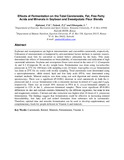| dc.contributor.author | Kiplamai, F. K. | |
| dc.contributor.author | Tuitoek, Prisca J. | |
| dc.contributor.author | Ethangatta, L. | |
| dc.date.accessioned | 2017-12-05T17:56:00Z | |
| dc.date.available | 2017-12-05T17:56:00Z | |
| dc.date.issued | 2010 | |
| dc.identifier.citation | Egerton Journal Of Science And Technology, 2010 Volume 8 issue 8 | en_US |
| dc.identifier.uri | https://scholar.google.com/citations?user=K57KFIQAAAAJ&hl=en | |
| dc.identifier.uri | http://hdl.handle.net/123456789/2939 | |
| dc.description.abstract | Soybeans and sweetpotatoes are high in micronutrients and convertible carotenoids, respectively. Utilization of micronutrients is hampered by anti-nutritional factors intrinsic to nutrient sources. Carotenoids must first be converted to retinol before utilization by the body. This study determined the effects of fermentation on bioavailability of micronutrients and utilization of high carotenoid substrates. Soybean and sweetpotato flours were mixed in the ratio of 1:1 (Composite A) and 1:3 (Composite B) on dry weight basis. Fermentation was done using Lactobacillus plantarum at 37oC for 168 hours with sampling every 24 hours. Aspergillus oryzae fermentation was done at 25oC for six weeks with weekly sampling. Total carotenoids were determined using a spectrophotometer, while retinol, lipid and free fatty acids (FFA) were determined using standard methods. Mineral analysis was done using wet acid digestion and atomic absorption spectroscopy. There was a significant (P<0.001) decrease in total carotenoids in both the L. plantarum and A. oryzae fermentation with a concurrent increase in retinol of 3 μg/g and 4 μg/g, respectively. There was an overall 30% increase in FFA in A. oryzae-fermented samples as compared to 12% in the L. plantarum-fermented samples. There were significant (P<0.001) differences in zinc and calcium contents fermented by the different organisms, but none in iron and magnesium contents. Calcium and zinc extraction was highest after 24 hours of L. plantarum fermentation. The findings suggest that fermentation could be effective in increasing mineral bioavailability, free fatty acid and retinol formation from substrates rich in carotenoids. Therefore, optimal time and microbe fermentation can be used to develop supplementary and complementary foods for people deficient in Vitamin A and minerals. | en_US |
| dc.language.iso | en | en_US |
| dc.publisher | Egerton Journal Of Science And Technology | en_US |
| dc.subject | Carotenoids | en_US |
| dc.subject | Retinol | en_US |
| dc.subject | Minerals | en_US |
| dc.subject | Fermentation | en_US |
| dc.subject | Vitamin A | en_US |
| dc.title | Effects of Fermentation on the Total Carotenoids, Fat, Free Fatty Acids and Minera ls in Soybean and Sweetp otato Flour Blends | en_US |
| dc.type | Article | en_US |

